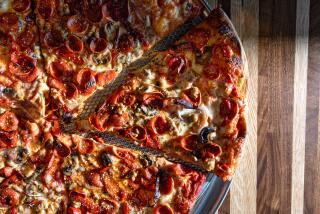It’s Perfectly OK to Roast Fresh Chestnuts Over an Open Fire--or in Your Oven
- Share via
Question: I just recently picked fresh chestnuts. Can they be roasted over an open fire in the fireplace or do they need to be oven-roasted? Please give me directions as soon as possible for they are beginning to shrivel.
Answer: It’s already that time of year, isn’t it? True to the line from that famous song, chestnuts certainly can be roasted over an open fire. There are actual chestnut roasting pans, but according to “The New Doubleday Cookbook” by Jean Anderson and Elaine Hanna (Doubleday: 1985), the nuts can also be simply placed at the edge of a fire near glowing coals and roasted about 10 minutes, turning frequently, until they pop. Then simply shell and eat.
Chestnuts may also be roasted in the oven, says John Hadamuscin in his book “The Holidays,” (Harmony: 1986, $19.95). “With a sharp knife, cut a cross in the flat side of each chestnut, then spread them on a greased baking sheet and roast at 375 degrees 5 to 7 minutes, or until the skins can be removed easily. Dump the chestnuts into a wooden bowl or basket and put out an extra bowl for the shells. Serve hot and let everyone peel his or her own.”
Q: I have a nephew, living in Greece, who must be on a gluten-free diet. Do you have any suggestions on where I can obtain a recipe for gluten-free bread? His parents tell me it is impossible to buy such bread over there.
A: The Rice Council of American, P.O. Box 740121, Houston, Tex. 77274 will mail a free copy of “Tasty Rice Recipes . . . for Those With Allergies” to anyone who sends a request and includes a self-addressed, stamped business envelope. The pamphlet includes wheat-free, wheat- and egg-free, wheat- and milk-free and wheat-, milk- and egg-free recipes, including one for rice bread formula.
Q: What are the contents, in general, of bottles labeled “liqueurs”?
A: Hurst Hannum and Robert S. Blumberg, authors of “Brandies and Liqueurs of the World” (Contemporary Books, 1979), say a liqueur is a sweetened spirit (either neutral grain alcohol or an eau de vie such as Cognac or Armagnac) that has been flavored by the skins, seeds, roots, flowers, leaves and pulp of various fruits and vegetables or by natural extracts or concentrates. Often the flavoring substance is mentioned in the product name or description. The word liqueur is derived from the Latin liquefacere, meaning to melt or dissolve.
Q: My husband and I would like to find more alternatives for red meat. I would like to begin using ground turkey. However, my husband has an occasional problem with gout and he tells me that turkey is a no-no. I’m not even sure what it is in a food that causes the problem.
A: When we turned to the National Turkey Federation with this question, they conferred with Beth Cavnough, Registered Dietitian, Lakeview Hospital, Stillwater, Minn. and Mary Englebretson, Registered Dietitian, United Hospitals, St. Paul, Minn. The dietitians, using as their source of information the Twin Cities District Dietetics Assn. Diet Manual, tell us patients with gout--excessive amounts of uric acid in the blood--are not restricted by diet. The condition is treated by medication that is deemed more effective.
In the case of an acute attack, a patient is advised to limit his/her intake of the following foods to two ounces a day: sweetbreads, liver, mackerel, anchovies, shrimp, gravy, alcohol, dried peas, lentils, wheat germ and bran, beef and poultry products. Turkey is not specifically listed or singled out. He should consult his physician, however, and follow his advice.
Yet another response to the Oct. 16 You Asked About . . . column on purchasing baking soda in Germany. B. Emerson of Montgomery, Ala. says it is sold as Kaisers Natro (natrium) in pharmacies.
More to Read
Eat your way across L.A.
Get our weekly Tasting Notes newsletter for reviews, news and more.
You may occasionally receive promotional content from the Los Angeles Times.










